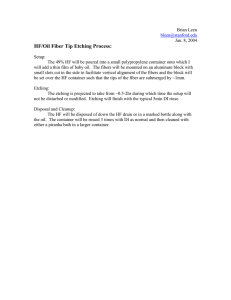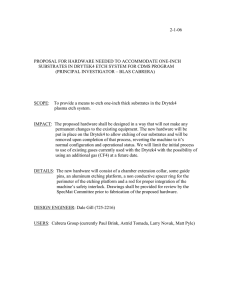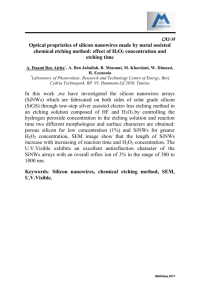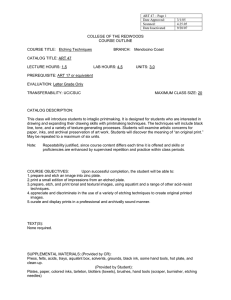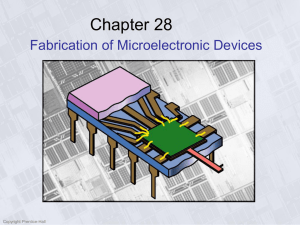Sidewall roughness control in advanced silicon etch process
advertisement
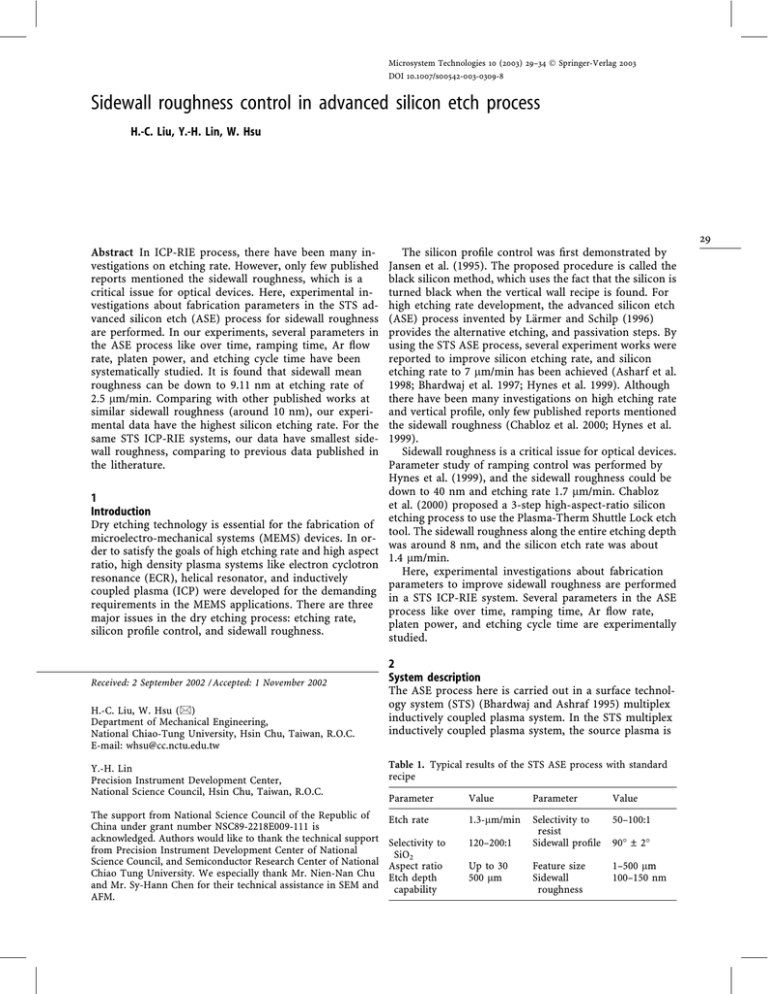
Microsystem Technologies 10 (2003) 29–34 Ó Springer-Verlag 2003 DOI 10.1007/s00542-003-0309-8 Sidewall roughness control in advanced silicon etch process H.-C. Liu, Y.-H. Lin, W. Hsu 29 The silicon profile control was first demonstrated by Jansen et al. (1995). The proposed procedure is called the black silicon method, which uses the fact that the silicon is turned black when the vertical wall recipe is found. For high etching rate development, the advanced silicon etch (ASE) process invented by Lärmer and Schilp (1996) provides the alternative etching, and passivation steps. By using the STS ASE process, several experiment works were reported to improve silicon etching rate, and silicon etching rate to 7 lm/min has been achieved (Asharf et al. 1998; Bhardwaj et al. 1997; Hynes et al. 1999). Although there have been many investigations on high etching rate and vertical profile, only few published reports mentioned the sidewall roughness (Chabloz et al. 2000; Hynes et al. 1999). Sidewall roughness is a critical issue for optical devices. Parameter study of ramping control was performed by Hynes et al. (1999), and the sidewall roughness could be down to 40 nm and etching rate 1.7 lm/min. Chabloz 1 et al. (2000) proposed a 3-step high-aspect-ratio silicon Introduction etching process to use the Plasma-Therm Shuttle Lock etch Dry etching technology is essential for the fabrication of tool. The sidewall roughness along the entire etching depth microelectro-mechanical systems (MEMS) devices. In orwas around 8 nm, and the silicon etch rate was about der to satisfy the goals of high etching rate and high aspect 1.4 lm/min. ratio, high density plasma systems like electron cyclotron Here, experimental investigations about fabrication resonance (ECR), helical resonator, and inductively parameters to improve sidewall roughness are performed coupled plasma (ICP) were developed for the demanding in a STS ICP-RIE system. Several parameters in the ASE requirements in the MEMS applications. There are three process like over time, ramping time, Ar flow rate, major issues in the dry etching process: etching rate, platen power, and etching cycle time are experimentally silicon profile control, and sidewall roughness. studied. Abstract In ICP-RIE process, there have been many investigations on etching rate. However, only few published reports mentioned the sidewall roughness, which is a critical issue for optical devices. Here, experimental investigations about fabrication parameters in the STS advanced silicon etch (ASE) process for sidewall roughness are performed. In our experiments, several parameters in the ASE process like over time, ramping time, Ar flow rate, platen power, and etching cycle time have been systematically studied. It is found that sidewall mean roughness can be down to 9.11 nm at etching rate of 2.5 lm/min. Comparing with other published works at similar sidewall roughness (around 10 nm), our experimental data have the highest silicon etching rate. For the same STS ICP-RIE systems, our data have smallest sidewall roughness, comparing to previous data published in the litherature. Received: 2 September 2002 / Accepted: 1 November 2002 H.-C. Liu, W. Hsu (&) Department of Mechanical Engineering, National Chiao-Tung University, Hsin Chu, Taiwan, R.O.C. E-mail: whsu@cc.nctu.edu.tw 2 System description The ASE process here is carried out in a surface technology system (STS) (Bhardwaj and Ashraf 1995) multiplex inductively coupled plasma system. In the STS multiplex inductively coupled plasma system, the source plasma is Y.-H. Lin Precision Instrument Development Center, National Science Council, Hsin Chu, Taiwan, R.O.C. Table 1. Typical results of the STS ASE process with standard recipe Parameter Value Parameter Value The support from National Science Council of the Republic of China under grant number NSC89-2218E009-111 is acknowledged. Authors would like to thank the technical support from Precision Instrument Development Center of National Science Council, and Semiconductor Research Center of National Chiao Tung University. We especially thank Mr. Nien-Nan Chu and Mr. Sy-Hann Chen for their technical assistance in SEM and AFM. Etch rate 1.3-lm/min 50–100:1 Selectivity to SiO2 Aspect ratio Etch depth capability 120–200:1 Selectivity to resist Sidewall profile Feature size Sidewall roughness 1–500 lm 100–150 nm Up to 30 500 lm 90° ± 2° 30 Fig. 1a, b. The effect of Ar in ASE etching step. a Trench and sidewall roughness with 40 sccm Ar flow rate; b Trench and sidewall without Ar in process Fig. 2a, b. The effect of platen power on sidewall perpendicularity at 1000 W coil power and platen power at a 48 W; b 36 W; c 24 W; d 12 W generated by an inductively coupled coil generator (1 kW, 13.56 MHz). The wafer is mechanically clamped to the platen electrode and the temperature can be maintained at 80 °C below. After performing the dry silicon etching, the etch profile of the trench is evaluated by a scanning electron microscope (SEM), and sidewall roughness of the trench is measured by an atomic force microscope (AFM). 3 ASE process The ASE process is based on the technique invented by Lärmer and Schilp, where the deposition of passivation layer and etching take turns in the silicon etch process. SF6 and C4F8 are used as the etching and deposition gases, respectively. The SF6 gas supplies fluorine radicals for 31 Fig. 3a, b. The trench profiles and sidewall roughness at etching cycle time of a 8 s; b 12 s; c 16 s, and d 20 s spontaneous isotropic etching of exposed silicon. The C4F8 plasma deposits a (CxFy)n polymeric passivation layer on all substrate surface. The balance between etching and deposition determines the final process results, and this balance can be controlled through a wide variety of process parameters, which will be studied here. cycle time, which are found to have obvious effect on sidewall roughness. The standard recipe used here is supplied by STS. Table 1 lists typical results of the ASE process by standard recipe. From our experimental investigations, these parameters are then adjusted one by one to improve sidewall roughness. 4 Parameters study In order to investigate the fabrication process to have smooth sidewall roughness and high etching rate, parameters study is performed, including ramping time, over time, Ar flow rate, platen power, SF6 flow rate, and etching 4.1 Ar flow rate and platen power In RIE process, etching mode contains ion-bombardment and chemical etching. The Ar can be added to increase the effect of ion-bombardment. In standard recipe, it does not contain Ar flow rate. Here, Ar is added to observe its effect 32 Fig. 4. The sidewall roughness at various ramping time and over time Fig. 5a, b. AFM images of trench sidewall at 2 s over time and zero ramping time. a 3-D diagram of sidewall surface; b Roughness analysis of sidewall surface on sidewall roughness. Figure 1 shows the difference with and without Ar in ASE process, where the platen power and coil power are 12 and 1000 W, respectively. In Fig. 1a, 40 sccm of Ar flow rate is set in the etching step. From Fig. 1a-2 and 1b-2, adding Ar in ASE etching step is shown to improve surface roughness. However, it is found that, with Ar, sidewall inclined angle is worse than the result of recipe without Ar, and 5% of Ar flow rate is suitable for sidewall roughness and profile control. The sidewall inclined angles are 88.85° in Fig. 1a-1 with Ar and 89.7° in Fig. 1b-1 without Ar. Anyway this negative taper profile can be improved by increasing the concentration of oxygen, so-called the black silicon method proposed by Jansen et al. (1995). b Fig. 6. Silicon etching rate at different SF6 flow rates with fixed pressure of 25 m Torr Not only Ar flow rate but also platen power is found to enhance the effect of ion-bombardment. The platen power source is located at the bottom of system. Figure 2 shows the relationship between the platen power and sidewall perpendicularity. Ar flow rate and coil power are set at 40 sccm and 1000 W, respectively, to observe the effect of platen power. Better sidewall perpendicularity is achieved at lower platen power. As shown in Fig. 2a and d, when the Fig. 7a, b. Sidewall roughness at SF6 flow rate of a 65 sccm; b 130 sccm; c 195 sccm; d 260 sccm Fig. 8a, b. The AFM image of trench sidewall surface. The sample used here is obtained at 20 Ar flow rate and 2 s over time. a 3-D diagram of sidewall surface; b roughness analysis of sidewall surface 33 platen power is 48 W, sidewall inclined angle is 85°, and it becomes 88.85° at 12 W platen power. Because a strong electric field in the sheath provides heavier ion-bombardment to the surface close to the platen power source when a larger platen power is applied. It is also found that the selectivity of photoresist to silicon becomes worse, and the phenomenon of undercut is more serious at deeper etching depth with stronger platen power. 34 4.2 Time control Here the influence of the etching cycle time to the sidewall roughness is studied. Figure 3 shows the trench profiles at different etching cycle time. With longer etching cycle time, the etching rate is higher and sidewall roughness is better, but sidewall perpendicularity becomes worse at the same time. At etching cycle time of 16 s, the inclined angle is 89.5°, etching rate is 2.8 lm/min, and sidewall roughness is 50 nm, as shown in Fig. 3c. When the etching cycle time is 20 s, the inclined angle is 88°, etching rate is 3.1 lm/min, and sidewall roughness is 40 nm, as shown in Fig. 3d. From the experimental investigations in Sects. 4.1 and 4.2, additional Ar flow rate, lower platen power, and longer etching cycle time are all found to be able to improve the sidewall roughness, but longer etching cycle time has less effect to sidewall perpendicularity. In the STS ICP-RIE system, ramping time can change the supplying time of SF6 and C4F8 in each cycle. Over time can control the overlap between etching and passivation cycle time. Figure 4 shows the SEM of trench sidewalls under different ramping time and over time. The tendency of sidewall roughness is evident. The sidewall roughness becomes smaller at longer over time and shorter ramping time in general. For example, with the standard recipe where the ramping time and the over time are all zero, the mean roughness is around 130 nm. When the ramping time is 0 s and the over time is 2 s per cycle, the mean roughness is calibrated as 19.1 nm, as shown in Fig. 5. etching rate. From experimental data, the highest etching rate is achieved at a proper SF6 flow rate, where the maximum etching rate of Si is 2.5 lm/min at SF6 of 130 sccm. This phenomenon also appears at the effect of SF6 flow rate to sidewall roughness. Figure 7 shows sidewall roughness at different SF6 flow rates, where sidewall roughness at SF6 flow rates of 130 sccm and 195 sccm are better than the surface roughness at SF6 flow rates of 65 sccm and 260 sccm. 4.4 Summary By the experimental study above, the mean roughness can be effectively improved by adjusting SF6 flow rate, etching cycle time, Ar flow rate, platen power, ramping time, and over time. When Ar flow rate is between 5% and 10% of SF6 flow rate, platen power is 12 W, and over time is 2 s, a smoother and better perpendicular sidewall surface can be achieved. At this recipe, the sidewall mean roughness is 9.177 nm with etching rate 2.5 lm/min, as shown in Fig. 8. 5 Conclusion A series of experiments are performed to improve the sidewall roughness with reasonable silicon etching rate and sidewall profile by adjusting various parameters in a STS ICP system here. The effects on parameters like gas flow rate, power, process cycle time are discussed. The sidewall mean roughness is demonstrated to be lower than 10 nm with etching rate about 2.5 lm/min. Comparing with other published works at similar sidewall roughness (around 10 nm), our experimental data have the highest etching rate. For the same STS ICP-RIE system, our experimental data show smallest sidewall roughness. References Asharf H; Bhardwaj JK; Hopkins S; Hynes AM; Johnston I; Mcauley S; Nicholls G; Atabo L; Ryan ME (2000) Advances in deep anisotropic silicon etch process for MEMS. 5th National Conference on Sensors and Microsystems, The Italian Association of Sensors and Microsystems, Lecce, Italy Bhardwaj J; Ashraf H (1995) Advanced silicon etching using high 4.3 density plasma. Proc SPIE Micromach Microfab Process Technol SF6 flow rate 2639: 224–233 In etching cycle, SF6 gas supplies fluorine (F) radicals for Bhardwaj J; Ashraf H; McQuarrie A (1997) Dry silicon etching for MEMS. The Symposium on Microstructures and Microfabricated spontaneous isotropic etching of exposed silicon by Systems at the Annual Meeting of the Electrochemical Society, mechanism illustrated below. Montreal, Quebec, Canada SF6 þ e ! Sx Fþ ð1Þ Chabloz M; Sakai Y; Matsuura T; Tsutsumi K (2000) Improvey þ Sx Fy þ F þ e ment of sidewall roughness in deep silicon etching. Microsys Si þ F ! Si nF ð2Þ Technol 6: 86–89 AM; Ashraf H; Bhardwaj JK; Hopkins J; Johnston I; Si nF ! Si Fx ðadsorbÞ ð3Þ Hynes Shepherd JN (1999) Recent advances in silicon etching for MEMS ð4Þ using the ASE process. Sensors and Actuators A74: 13–17 Si Fx ! Si Fx ðgasÞ Jansen H; Meint de Boer; Legtengerg R; Elwenspoek M (1995) Etching rate is limited by the ratio of F radical and SiFx The black silicon method: a universal method for determining the parameter setting of a fluorine-based reactive ion etcher in deep (gas) and the mean free path of F radical. When the SF6 flow rate is getting larger, etching rate is increased due to the silicon trench etching with profile control. J Micromech Microeng 5: 115–120 higher concentration of F radical. However, too much F Lärmer F; Schilp A (1996) Method of anisotropically etching radical may dilute the SiFx (gas) concentration and decrease silicon. German Patent DE4241045 the mean free path of F radical, so that the diffusion Takashi A; Masayoshi E (2000) One-chip multichannel quartz control will dominate the etching process to reduce the crystal microbalance (QCM) fabricated by Deep RIE. Sensors and etching rate. Figure 6 shows the effect of SF6 flow rate to Actuators A82: 139–143

